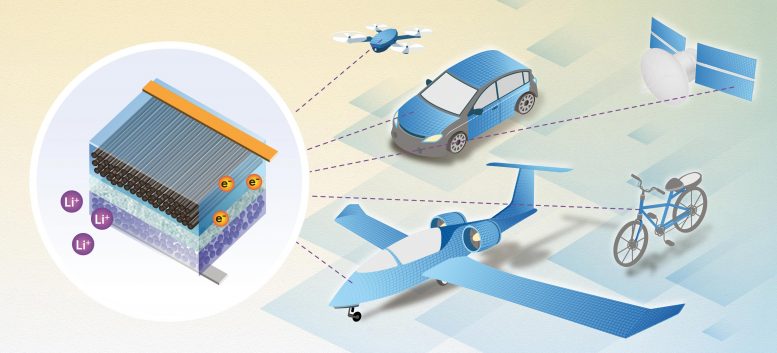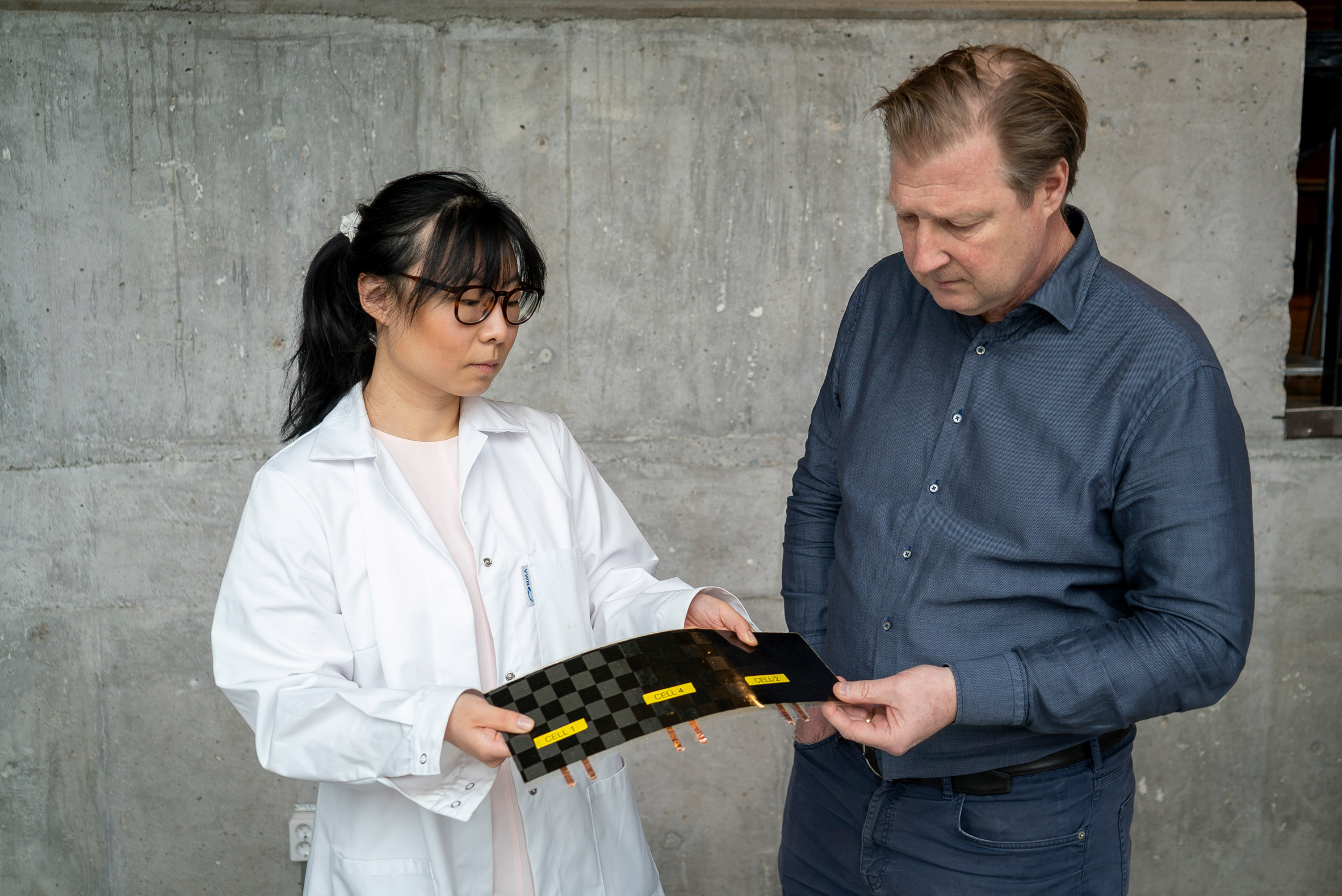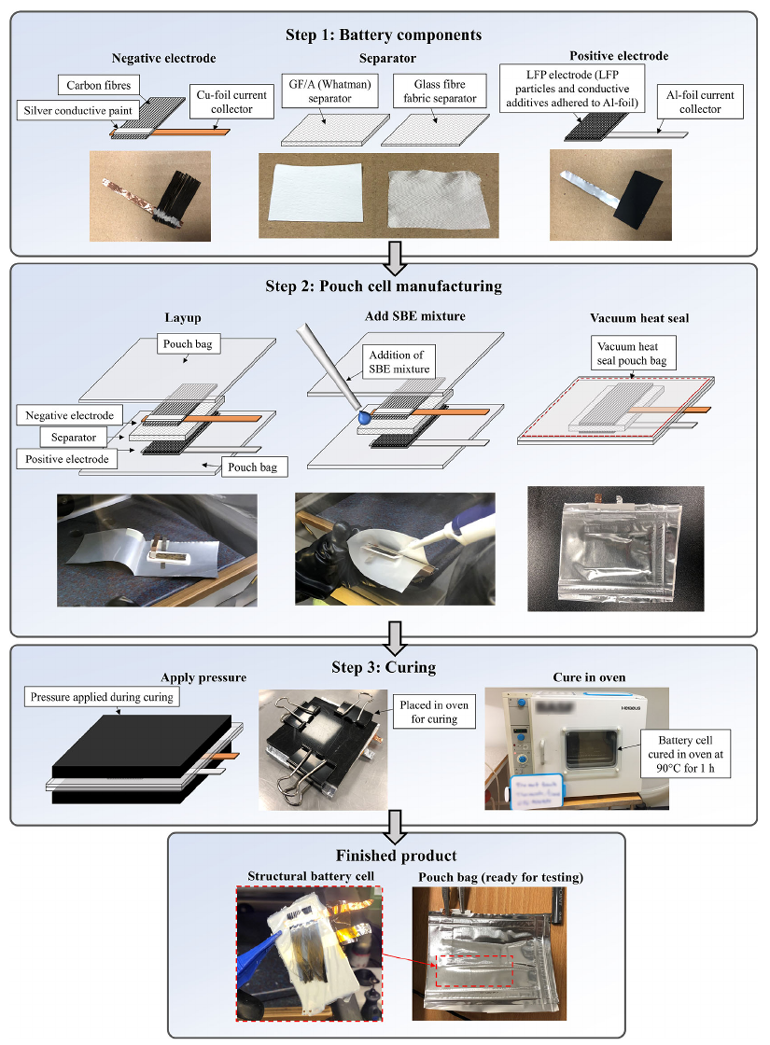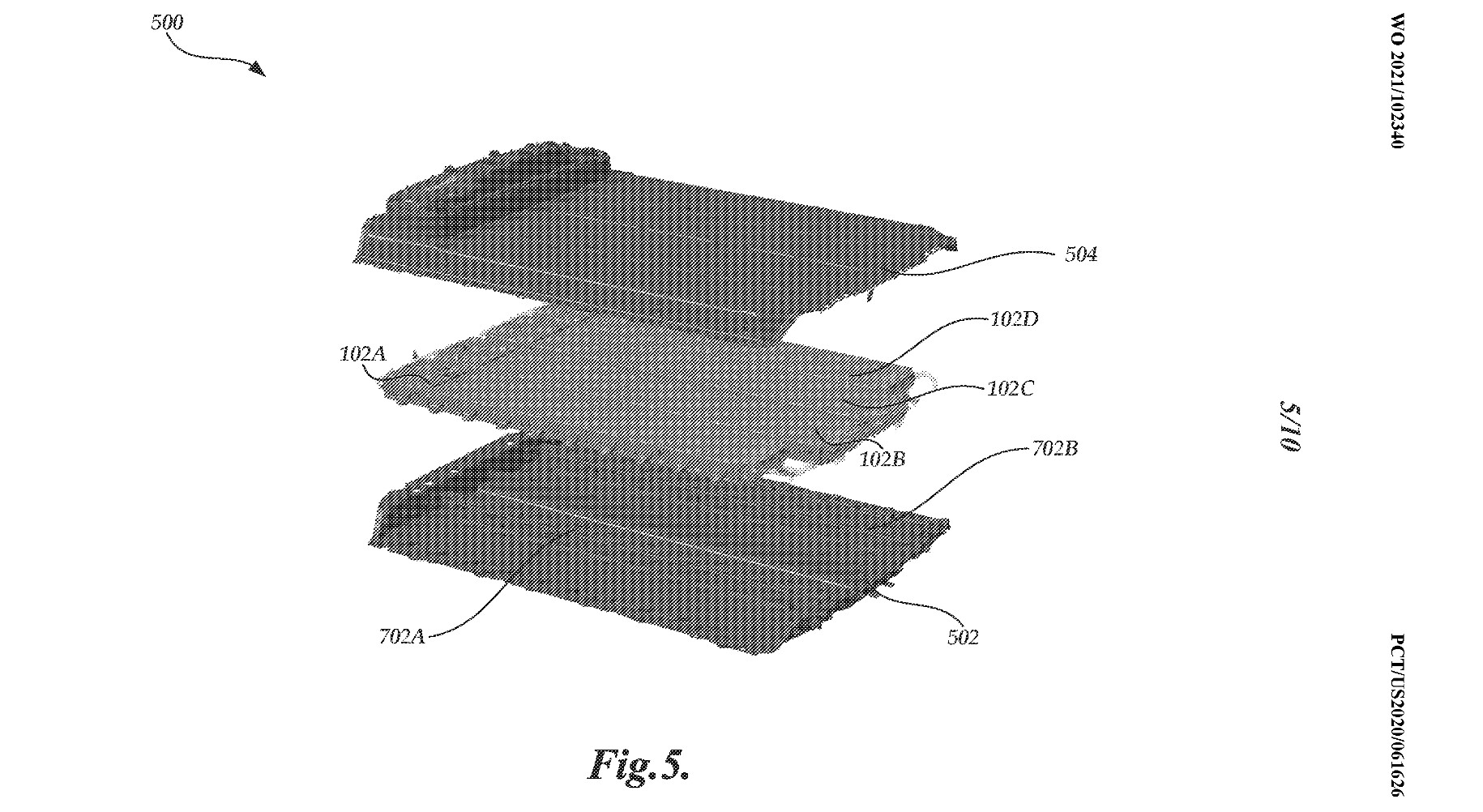The biggest roadblock to the widespread, mainstream adoption of electric vehicles is range. We’re typically seeing 300 miles or less for most EVs on the market, which is more than enough for daily driving, but still not enough to put range anxiety to rest. Because of a battery packs incredible weight, there’s a balance that EV makers have to find. Less weight means less energy needed to move the car, but also less overall range. Add more battery to get more range and you’ve increased the weight and amount of energy needed to move. But what if we could take some of that weight out of the equation? Imagine a car that has no battery pack because the car’s structure is the pack?
A team at the Chalmers University of Technology in Sweden has successfully created a battery with carbon fiber as a structural electrode. What this means is a battery that can act as actual structure for a device. There’s no separate battery pack when the structure itself is the pack. But a structural battery isn’t exactly a new idea. This advance is different, but to understand why it has so much promise let’s take a quick step back.
This concept is widely used in aerospace applications, in which weight is a major driving factor. On passenger planes, for example, fuel tanks are usually integrated into the wings, and even when there are also tanks inside the aircraft’s body, the wing tanks are used primarily.
There are a few types of Aircraft Fuel Tanks, but on many aircraft, especially in transport and high-performance aircraft, part of the wings or fuselage structure is sealed with a fuel-resistant two-part sealant to form a fuel tank. With the lowest weight, the sealed skin and structural members provide the highest volume of space available. The tank is a unit within the airframe structure, which explains the pretty obvious name, “integral fuel tanks”. 1 2

It’s a fascinating approach that provides several benefits. It reduces the stress on the wings during takeoff and flight by putting the heavy fuel directly inside the source of lift. On top of that, using the wing itself to store fuel is a very efficient use of space. It’s too narrow to be used to store any significant amount of cargo, so why not? And then there’s safety. If there’s some kind of ground fire, passengers have evacuation options since the fuel is isolated from the fuselage, and if the fuel pumps break or a fault occurs, the engines will still be fed with gravity. 1 3 4

In current electric cars, the battery cells add significant weight, require a special pack structure and protection from impacts, and in most cases they aren’t used for any load-bearing function in the overall structure … yet. With the aim to solve those problems, at Tesla’s Battery Day event last year they not only unveiled a new 4680 battery cell, but also a new battery architecture built around the new cell. A “structural battery”. 5 6
In order to bring this approach to EVs, Tesla decided to build a battery pack that acts as body structure, linking the front and rear underbody parts. In this case, there’s no separate battery pack because the car’s bottom side is the pack.6 7
Currently, Tesla builds battery packs by combining cells into modules, modules into a battery pack, and then the battery pack is installed into the base of the vehicle platform.
In this new concept, Tesla isn’t using modules. Instead, it’s building the entire battery pack as the structural platform of the vehicle, with the battery cells glued into the sandwich, and helping to join the platform as one big unit. This new design reduces the number of parts and the total mass of the battery pack, so that less energy is needed by the EV, which can increase the range of its vehicles. They believe that the the structural battery can reduce overall vehicle weight by 10% and increases range by 14%. 6 8 This goes right back to what I said at the beginning about EV makers trying to find that perfect balance between weight and the energy needed to move.
Elon Musk said:
“Battery pack will be a bonded structure with cells providing shear transfer between steel upper and lower face sheets, eliminating most of the center body parts while providing better torsional rigidity and improved polar moment or inertia.”

And that brings us back to the research breakthrough that’s taking this to another level.
A team at Chalmers University of Technology in Sweden has successfully used carbon fiber as a structural electrode. For several years, they’ve been studying the relationship between carbon fiber’s microstructure and electrochemical capacity.
Their structural battery contains a multifunction carbon fiber that works as a conductor, electrode, and load-bearing material. This latest advancement may lead to essentially “massless” energy storage in vehicles and other mobile technologies. 5

Since 2007, the scientists have been attempting to develop a truly structural battery, but it’s been challenging to produce batteries that have both outstanding mechanical and electrical properties.
But now, the Chalmers University’s team, in association with KTH Royal Institute of Technology that’s based in Stockholm, have taken a big step forward. The new battery has properties that go beyond anything that’s been seen yet for strength, stiffness, and excellent potential to chemically store electrical energy.
According to the researchers, the performance of this battery is 10 times more than the previous versions of structural batteries. But there’s something important to note about its energy density. It’s only at 24 Wh/kg, which they acknowledge is around 20% of the capacity of comparable lithium-ion batteries available today.
While that might sound like a drawback at first, less energy will be required to drive an electric car since the vehicle’s weight can be significantly reduced. Instead of needing to integrate so many cells into a skateboard of an EV, like the method of filling the cavity of a wing with fuel, you could have panels of a car that are batteries. It’s not a separate panel hiding a battery, but it’s the battery itself. So the weight of the panel, which you’d have anyway, is now also providing a certain level of energy storage too.
Taking the Tesla model S as an example, its 85 kWh battery accounts for 25% of the total vehicle weight, which is considerable. And while the Chalmers’ battery, which is still in the research phase, doesn’t have the same energy density, at some point you could potentially offload a lot of that energy storage capacity to the structure. We don’t necessarily need the same 300+ Wh/kg that Tesla has today, but if it gets close enough — along with high enough voltages — with the weight savings, it could make it a viable option.
In addition, the new carbon fiber battery’s design has an increased stiffness of 25GPa (similar to many construction materials) and a tensile strength exceeding 300MPa, which gives it excellent rigidity. The higher the stiffness the less likely something is to undergo elastic deformation, which means how something deforms non-permanently. 5 9 10
Leif Asp, Professor at Chalmers and leader of the project said:
“Previous attempts to make structural batteries have resulted in cells with either good mechanical properties, or good electrical properties. But here, using carbon fiber, we have succeeded in designing a structural battery with both competitive energy storage capacity and rigidity.”

The new structural battery features a positive electrode composed of a lithium iron phosphate-coated aluminum foil and a negative electrode made of carbon fiber. These electrodes are separated by a fiberglass fabric, in a matrix electrolyte.

Consider a possible application of the 24Wh/kg battery to the Calin Gologan’s Solar Elektra One Electric Airplane that was introduced in 2012. The plane was 1/3 structure, 1/3 batteries, and 1/3 payload including pilot. Each third was 100 kilograms (220 pounds). Being able to replace half the structure with Chalmers’ structural battery material, 50 kilograms (110 pounds) of the airframe would be capable of storing 1,200 Watt-hours, shaving 4.6 kilograms (10.1 pounds) from the battery weight. Although it doesn’t sound like a big number, reducing 1.5 percent of the total weight can make a big difference.
Chalmers researchers expect up to three times the energy density for future products, so the 1.5% weight reduction of the last example could be turned into something like 4.5%. And if those structural panels were also solar panels … you get the idea. 11
But there is a possible downside to structural batteries, and something I’m sure some of you where thinking about and possibly commenting on already. What if the structural pack or battery are damaged in some way, like a collision?
A recently published patent for Tesla’s structural battery pack not only discusses cost reduction and range improvements of its next-generation batteries, but also how the structural battery packs could help keep — if not improve — its vehicles’ safety.
According to the patent, the bottom of the battery pack could be manufactured with a strong and rigid material that would also intentionally deform if it was involved in a crash. The structural battery pack patent also pointed out how parts of the integrated energy system are designed to allow gasses to escape from the battery in the event that a cell becomes damaged.

The section from Tesla’s structural battery pack patent affirms:
“In one embodiment, the bottom layer is made from a material that has sufficient stiffness and strength to support the battery cells and react mechanical loads from normal vehicle operation, but also can deform in response to a road strike from below that would otherwise cause failure in the battery pack system.” 12 13
If the safety benefits of structural batteries mentioned in Tesla’s patent can really come true, it could make some of the safest cars on the road even safer.
Getting back to the Chalmers University of Technology, although they’ve succeed in creating a structural battery ten times better than all previous ones, the researchers didn’t choose the materials to try and break records. Instead, they wanted to investigate and understand the effects of material architecture and separator thickness. This is pretty common in battery research. They test one specific aspect, get results, adjust, and test something else next. It’s a long, tedious process.
This research got the interest of the Swedish National Space Agency, which is funding a new study on the performance of the structural battery and how it can be improved. In the positive electrode, the aluminum foil will be replaced with carbon fiber as a load-bearing material, providing both increased energy density and stiffness. On top of that, the fiberglass separator will be substituted by an ultra-thin variant, and should also show faster-charging cycles. It’s expected that the new study will be concluded in less than two years … like I said … battery research is a long, tedious process.
In the end they believe that this battery can reach a stiffness of 75 GPa and an energy density of 75 Wh/kg. That would make the battery almost as strong as aluminum, but with lower weight, as well as increased safety. 5
But when might we see these structural batteries on the market? Tesla is expected to use 4680-format cells in the Cybertruck, which will be built alongside the Model Y in Texas. And the Chalmers’ battery is still a LONG way off from production, but it shows a clear sign of where batteries may end up. Just imagine electric bikes, EVs, and portable devices being powered by massless structural batteries like this. If they can deliver, there’s a huge amount of potential.
- Aircraft Fuel Tanks ↩︎
- Types of Aircraft Fuel Tanks ↩︎
- This is Why Fuel Tanks are Located in Aircraft Wings ↩︎
- Why Airplanes Store Fuel in the Wings (wet wings) ↩︎
- New Structural Battery Enables “Massless” Energy Storage ↩︎
- First look at Tesla’s new structural battery pack that will power its future electric cars ↩︎
- A sneak peek at Tesla’s new structural battery pack ↩︎
- Tesla unveils battery puzzle pieces of smart material science, design, and manufacturing innovation ↩︎
- “Structural” Battery Design Reduces “Dead” Enclosure Weight ↩︎
- Chalmers researchers one step closer to using carbon fiber as a structural battery ↩︎
- Massless Batteries for Aircraft? ↩︎
- Tesla structural battery pack patent hints at clever contingencies for crashes, cell failures ↩︎
- What Happens If Tesla Structural Battery Pack Is Damaged, Fails? ↩︎

















Comments